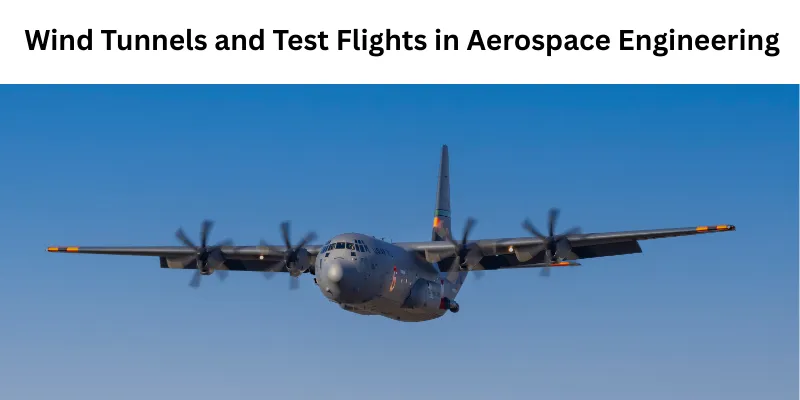

Imagine testing a billion-dollar aircraft by blowing air over a small model—it sounds simple, but it’s powerful. Over time, flight testing has evolved from a matter of guesswork to a precision science.
Even today, with the advancements of AI and computer simulations, wind tunnels and real test flights remain key to developing safe and reliable aircraft.
Most imagine a wind tunnel as a big fan in a tube, but it’s far more. It’s a crucial tool that shows engineers how air flows around planes, rockets, or cars—long before they leave the ground.
What Is a Wind Tunnel Really?
A wind tunnel is a controlled testing environment where air is moved past a model to simulate flight. It allows engineers to study lift, drag, pressure, and turbulence—without needing to launch the actual aircraft. Instead of flying through the air, we make the air fly around the model.
Not just a big fan and tube—break the stereotype.
Sure, there’s a fan—but wind tunnels are built with advanced engineering. They have precision nozzles, smooth walls, sensors, and powerful computers to measure everything happening during the test. It’s not just about blowing air; it’s about understanding how air behaves.
Types: Subsonic, Supersonic, Hypersonic, and Why They Matter.
Not all wind tunnels are the same. They are designed based on the speed of airflow:
Each type helps test aircraft under different flight conditions—from takeoff to space re-entry.
Miniature Planes, Mega Discoveries
Engineers rarely test full aircraft in wind tunnels. Instead, they use scale models built to mirror real performance. Sensors capture data to:
Tests often uncover surprises—like airflow shifts in sharp turns or small changes increasing drag—beyond computer predictions.
Behind the Scenes: Wind Tunnel Testing in Iconic Projects
Wind tunnels have shaped major aerospace milestones. Concorde, the Space Shuttle, and even Mars Rovers relied on extensive tunnel testing.
Centers like NASA Ames and Germany’s ETW still lead in advancing aircraft, spacecraft, and drones. Though old-school, wind tunnels remain vital—revealing insights beyond simulations and turning concepts into flight.
When an aircraft leaves simulation for real flight, it faces the true test. Software can’t capture everything—shifting weather, sudden vibrations, or the pilot’s experience in the cockpit remain unpredictable.
Simulations Can’t Replicate Everything
Computer modeling and AI help engineers design, test, and cut costs, but reality doesn’t always match code. Air shifts at high altitudes, while gusts, turbulence, and even sun-heated surfaces alter performance in ways no simulation can fully predict.
Test Pilots: The Aerospace Daredevils
Test pilots are more than expert fliers—they’re engineers, detectives, and risk-takers. They push aircraft to extremes, record data, and describe the flying experience. With sharp reflexes and steady nerves, they face the unknown. Chuck Yeager, who broke the sound barrier in 1947, proved the power of real-world testing.
High Stakes: What Could Go Wrong?
Test flights are risky and have caused accidents that reshaped safety rules. Early jets faced dangerous stalls, but lessons made today’s aircraft safer. Real flight data brings surprises—better or worse than expected—driving progress.
Keep reading to see how wind tunnels and real flights work together to fix flaws and boost aviation.
In aerospace engineering, testing isn’t linear—it’s a loop. Engineers shift between wind tunnels and test flights because designs that work in the tunnel can act differently in the sky.
The Boeing 787 proved this when early flights exposed unexpected vibrations, sending engineers back to refine designs before passengers ever boarded. SpaceX takes the same iterative path: launch, observe, adjust, repeat—showing that each “failure” is progress.
This “Fail Fast, Learn Faster” mindset turns mistakes into data. Every cycle of testing makes aircraft safer, more efficient, and more advanced—turning challenges into fuel for innovation.
AI, digital twins, and high-performance computing allow aerospace engineers to run realistic flight simulations, predicting airflow, weather, and enabling virtual test flights before parts are built. Digital twins replace physical models, AI explores countless design options, and HPC cuts testing from months to days.
Still, real-world trials are vital—airflow and material behavior can’t be fully simulated. Wind tunnels, test flights, 3D-printed models, sensors, and VR continue to reveal flaws. The future depends on blending fast digital tools with physical tests for safety and accuracy.
When you hear “wind tunnel,” you may think of airplanes and rockets. But these air tunnels go beyond aerospace—shaping sports, architecture, and even future personal transport.
Wind Tunnels for Olympic Cycling Suits
Olympic cyclists fight for every fraction of a second. Wind tunnels shape suits that reduce drag, while testing positions and fabrics transform science into speed.
Shaping Skyscrapers
Before reaching the sky, skyscrapers must face the wind. Engineers test them in wind tunnels to see how they handle storms and gusts, ensuring designs remain both striking and safe.
Drones in the Breeze
From delivery drones to aerial photography, wind tunnels fine-tune stability and efficiency. They help drones fly smoothly, even in tricky weather, improving safety and battery life.
Mastering both wind and wings is what makes aerospace engineering truly remarkable. It’s a balance of precision, creativity, and bravery—where science meets bold exploration.
Every test in wind tunnels and skies pushes boundaries, turning daring ideas into safe, reliable aircraft that inspire the future of flight.